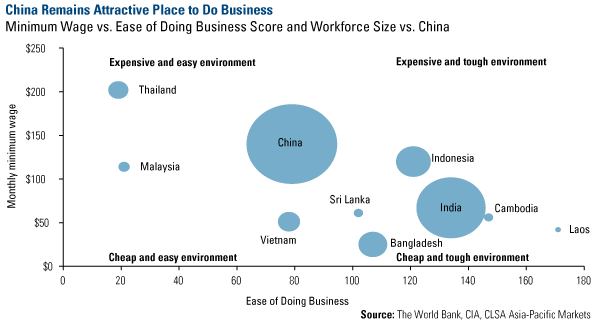
At the CLSA AsiaUSA Forum in San Francisco earlier this month, numerous opportunities for U.S. businesses in China were discussed. Factors affecting growth in China are the Asian middle class, an increasing urbanization rate, and additional disposable income. The latter has been partially spurred by recent increases in wages. In fact, many people in China saw their wages rise 20 to 30 percent last year.
However, while these wage increases have been positive to the Chinese consumer and the companies which sell the goods, they have prompted many people to ask me how rising wages affect China’s status as a low-cost manufacturing hub for the world. Does this reduce the profitability of companies that expect to continue to benefit from the country? And, will China continue to drive resource demand?
This is where CLSA’s more balanced view of China’s business landscape is not only helpful, but essential. It is not enough to look at rising wages to appreciate how attractive China is for businesses. To get a better understanding, let’s compare three factors—the World Bank’s Ease of Doing Business score, minimum wage and workforce size—across several Asian markets. The World Bank annually analyzes regulations that either enhance or constrain business activity among 183 economies. For a business that wants to expand into different markets, this report is helpful in determining the ease or difficulty in obtaining construction permits, electricity and credit, as well as hiring workers and trading across borders.
On the World Bank’s scale, the business environment is easier in Thailand and Malaysia than in China and Vietnam, and companies would find it even more difficult to expand their businesses into Indonesia, India and Cambodia. However, Indonesia, India and Cambodia have cheaper labor markets than China or Thailand. But of all of these countries, China offers the largest labor market. CLSA says China makes for an “appealing hub for manufacturing” when you evaluate its unique combination of strengths together.
In addition, China’s workforce is better educated and more highly skilled compared to other Southeast Asian countries, says CLSA. China was also named the “world’s most connected economy” by the United Nations Conference on Trade and Development’s Liner Shipping Connectivity Index, when it comes to how integrated global shipping networks are to enable worldwide trade. The country also has superior infrastructure and trade connectivity compared to many emerging markets, “even occasionally besting developed economies,” says CLSA.
From the article entitled, “With Rising Wages, Will China Remain a Manufacturing Hub?” by Frank Holmes. Frank Holmes is chief executive officer of U.S. Global Investors – a registered investment adviser that manages approximately $2.8 billion. The information provided herein has been provided to MiningFeeds.com by the author and, as such, is subject to our disclaimer: CLICK HERE.



 Follow us on Twitter
Follow us on Twitter Become our facebook fan
Become our facebook fan











Comments are closed.